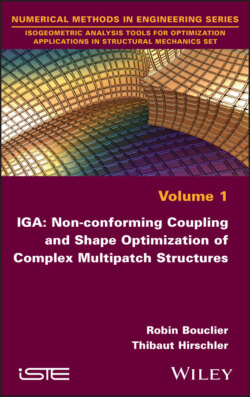Читать книгу IGA - Robin Bouclier - Страница 13
1.2.1. Parametric representation of geometries
ОглавлениеThe spline formalism offers a natural way to represent geometries in the parametric form. Hence, let us specify the parametric representation of geometries before entering into the details of the B-spline and NURBS technologies. To begin with, we consider univariate geometric entities living in 2D physical spaces. These entities simply consist of planar curves. Describing these curves in the parametric form consists of expressing each coordinate of a point on the curve separately as an explicit function of an independent parameter (Piegl and Tiller 1997):
[1.1]
where 1 is the parameter space (usually taken as the normalized interval [0, 1]), i.e. that defines the space of variation of parameter ξ1. As examples, we provide the parametric descriptions of the line and the circle depicted in Figure 1.1. The line is defined as:
[1.2]
Figure 1.1. Two simple planar curves
Parameter ξ1 takes any real value to represent the complete line or is bounded to represent a segment of the line. Using the same idea, the curve of the circle can be parameterized as follows:
[1.3]
Note that at this stage the parameterization is not unique and parametric forms are obviously not the only way of representing curves. Implicit equations are also commonly used to describe curves. For example, the circle of radius R and centered at the origin can be described by:
[1.4]
Both techniques have different advantages. The parametric form gives a direct way to compute a point on a curve. On the other hand, with the implicit form, it is easy to determine if a given point is on the curve or not.
The previous concept can be straightforwardly extended to multivariate geometric entities living in 2D or 3D physical spaces. There exist typical examples like those represented in Figure 1.2. For example, the unit surface sphere can be parameterized as:
[1.5]
with:
[1.6]
Two parameters are needed to describe a surface (θ and ϕ for the sphere). For describing a volume, three parameters are required. For example, the hollow cylinder from Figure 1.2 is described by:
[1.7]
with
[1.8]
NOTE.– Finally, note that the direct description of geometric entities in the parametric form may not be possible when these differ topologically from a square or a cube. In this case, Boolean operations between different parametric entities may be required to intersect and/or join them. We will see that this issue is reflected in IGA: it leads to facing non-conforming multipatch analysis, which is one of the current important challenges in the field and is largely addressed in this book.
Figure 1.2. Two simple (surface and volume) geometric objects
